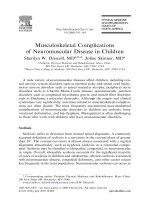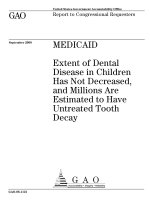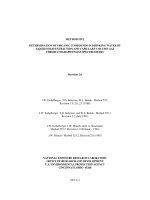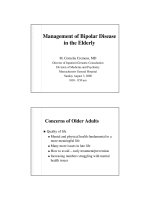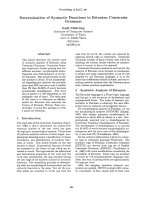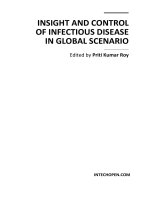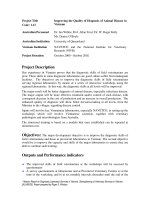Determination of causative bacteria agent of hemorrhagic disease in mudskipper (pseudapocryptes elongatus)
Bạn đang xem bản rút gọn của tài liệu. Xem và tải ngay bản đầy đủ của tài liệu tại đây (718.37 KB, 27 trang )
MINISTRY OF EDUCATION AND TRAINING
CAN THO UNIVERSITY
NGUYEN THU DUNG
DETERMINATION OF CAUSATIVE BACTERIA
AGENT OF HEMORRHAGIC DISEASE
IN MUDSKIPPER
(Pseudapocryptes elongatus)
Major in Aquaculture
Identification code: 62620301
SUMMARY OF DOCTORAL DISSERTATION IN AQUACULTURE
2015
This study was achieved at the College of Aquaculture and
Fisheries, Can Tho University.
Scientific advisors: Assoc Prof. Dr. ĐANG THI HOANG OANH
Reviewer 1:…………………………………………………………...
Reviewer 2:…………………………………………………………...
Reviewer 3:…………………………………………………………...
This dissertation was defended at the University Examination Committee
At………………………………………………………………...
At ……hour….., on date………month……..year………………
The dissertation is available at:
1. Center for education materials of Can Tho University
2. National library
MINISTRY OF EDUCATION AND TRAINING
CAN THO UNIVERSITY
NGUYEN THU DUNG
DETERMINATION OF CAUSATIVE BACTERIA
AGENT OF HEMORRHAGIC DISEASE
IN MUDSKIPPER
(Pseudapocryptes elongatus)
Major in Aquaculture
Identification code: 62620301
SUMMARY OF DOCTORAL DISSERTATION IN AQUACULTURE
Scientific advisors:
Assoc Prof. Dr. ĐANG THI HOANG OANH
2015
Chapter 1. OVERVIEW OF THE DISSERTATION
1.1 Introduction
Mudskipper (Pseudapocryptes elongatus) is a special species of high
economic value, are consumed widely in domestic and export value.
Mudskipper cultures in the provinces Mekong Delta region, however, in the
recent times mudskipper were sick with pathological signs of hemorrhage
in the body, at the fin and anal with a high mortality rate and widespread.
Most of determination of hemorrhagic disease are bacteria.
Streptococcus agalactiae is typical as the causative agent of tilapia
(Oreochromis sp.) (Pham Hong Quan et al., 2013), red tilapia
(Oreochromis sp.) (Dang Thi Hoang Oanh and Nguyen Thanh Phuong,
2012). S. iniae on seabass (Latex calcarifer) (Tran Vi hich and Nguyen
Huu Dung, 2011), Japanese flounder (Paralichthys olivaceus), red croaker
(Sciaenops ocellates) (Eldar et al., 1999). In addition, fish diseases are
caused by S. dysgalactiae in mullet (Liza alata, Liza haemotocheila) (Qi et
al., 2013), sturgeon (Acipencer schrenckii) (Yang and Li, 2009), fish
brown (Mugil cephalus) and cobia (Rachycentron canadum) (Abdelsalam
et al., 2009).
Determination of hemorrhagic disease also is found from many
different species as Aeromonas hydrophila bacteria (Loan et al., 2009),
Vibrio parahaemolyticus and V. alginolyticus on grouper (juvenile and
grow up) (Somkiat Kanchanakhan, 1996; Nguyen Thi Thanh Thuy et al.,
2009 was quoted by Vo Van Nha, 2012).
Because of various agents causative diseases, so the prevention and
treatment of dengue in aquatic animals are only effective when the agent
and the cause is pinpointed. Currently, determination of hemorrhagic
disease on mudskipper isn’t researching, to provide information for disease
prevention and treatment hemorrhagic on mudskipper "Determination of
causative bacteria agent of hemorrhagic disease in mudskipper
(Pseudapocryptes elongatus) " is researched.
1.2 General objective of the study
Survey and assessment of hemorrhage appear on a mudskipper farm
in Bac Lieu province. Identifying characteristics of Pathology in fish
pathogens which proposed solutions to prevent and treat the disease
effectively.
1.3 Scientific significance and applicable ability of the dissertation
Information from the results of an mudskipper condition and prevent
disease process will contribute to limit the damage in the farming process
1
mudskipper effective on economic productivity and income generation for
farmers.
1.4 New findings of the dissertation
Identifying the causative agent of hemorrhagic disease in mudskipper
is S. dysagalactiae and the time the disease usually appear in mudskipper
ponds.
A polymerase chain reaction (PCR) was preformed and optimized for
detection of S. dysgalactiae bacteria to apply early diagnosis, rapid and
specific the causative agent of hemorrhagic disease in mudskipper.
Recommend some antibiotic treatment of hemorrhagic disease in
mudskipper.
Chapter 2. LITERATURE REVIEW
In the literature review, the thesis described and analyzed the issues
related to the situation of indentured mudskipper as well as the study of
certain types of pathogenic bacteria on the fish to the main contents:
- The situation of indentured mudskipper in the world and country.
- The situation of the disease appears on mudskipper.
- Overview of hemorrhagic disease in fish.
- Overview of the characteristics of the bacteria on the fish.
- Overview of the situation pathogens Streptococcus on brackish and
sea fish.
- Determination of the virulence of some strains of the bacteria that
cause hemorrhagic disease.
- Diagnosis of hemorrhage.
- Prevention and treatment of dengue in fish.
Chapter 3. METHODS OF THE STUDY
3.1 3.1 Study periods and site
Time to research: from September, 2011 to December, 2014
3.2 Study species: Mudskipper
3.3 Study methods
3.3.1 The interview
3.3.1.1 The secondary data
Collected from the report of specialized agencies in Bac Lieu
province. Secondary data include aquaculture situation and the situation of
mudskipper farm in Bac Lieu.
3.3.1.2 The primary data
Interview 90 farmers mudskipper commercial in Bac Lieu town, Hoa
Binh District and Dong Hai District, Bac Lieu province. Primary data
2
include basic information, experience, culture techniques, information on
fish diseases and how to treat the disease when mudskipper disease.
3.3.2 Fish sampling methods
- Fish sample: mudskipper live, sample of 254 fish living in 34
pounds (11 ponds normal, 23 ponds have a mudskipper hemorrhagic
disease).
- Conditions for sampling: fish are 2-3 months old, weight 15-25
g/fish. Sampling time is 7-8 am.
3.3.3 Testing Method parasites
The number of test samples of parasitic is 120 samples in 12 ponds,
include 04 sampling sessions, each of 03 ponds, each pond 10 fish. Check
the skin, gills and gut a fish.
The level of parasite infection:
The rate of infection = (The number of infection samples/Total
samples tested) x 100
The intensity of infection = (The number of parasite/Fish, organ,
lame, microscope)
3.3.4 The method of sample analysis bacteria
3.3.4.1 Giemsa staining method
To spread kidney samples up lame. Samples were fixed in methanol
for 1 minute. Giemsa staining method according Humason, 1979 cited by
Rowley, 1990. Read the results by a microscope at 100X with oil drop.
3.3.4.2 The method of isolation and identification of bacteria
- Use a sterile scalpel incision in the kidney. Through kidney by
implanting, twist to take samples and cultured on agar plate. Incubate plates
in an incubator at a temperature of 28°C. After 24-48 hours, read the
results.
- Check the net of bacteria, oxidase, catalase, O/F, capability
development of bacteria in the environment TSB (+ 6.5% NaCl), the
hemolytic ability of bacteria.
d. The method of identification of bacteria by API 20 Strep kit
(Biomérieux, Pháp)
Random identifier 32 strains of bacteria collected is obtained
sampling 06 times by API 20 Strep kit.
3.3.5 The identification of bacteria by sequencing method
3.3.5.1 The method of bacterial DNA extraction
The process of DNA extraction from bacteria applied by the method
of Bartie et al. (2006). Bacteria proliferate raised from 16-18 hours in 5 ml
of NB (+ 1.5% NaCl) at a temperature of 28ºC, DNA extraction by 1.5 ml
3
of bacteria to the centrifuge tube with 100 mM Tris-HCL l 10, 1 mM
EDTA, pH 8.0 (TE). The mixture was heated at 95ºC for 15 minutes, then
cooled in ice and centrifuged for 2 minutes at the speed of 14,000
circle/min to separate the DNA solution and stored at -20ºC until use.
3.3.5.2 The method of sequencing 16S rRNA gene of bacteria
10 bacterial samples selected isolated from the results identified by
the method of 16S rRNA gene sequencing include: B1-6T; B2-5G; B23TT; B6-9TT; A1F1; A1F2; A1F4; A1F6; A1F9; A5F4. The PCR product
samples were sent to laboratory NK-Biotek and R & D units of companies
Nam Khoa. Sequencing products were run electrophoresis sequencing
machine ABI 3130XL sequencer 16 capillar. The results sequencing of 16S
rRNA gene were compared using the program Blast search on the database
of NCBI gene bank.
3.3.6 The method histopathology
The number of samples analyzed, including 127 fish. Sampling gill
tissue, liver, kidney of healthy fish and fish disease. The samples were cut
to a thickness of 5-7 mm, and then processed by automated handling
machines through stages dehydrate, making the coated sample and paraffin.
Casting blocks and cut with a thickness of 4-6 μm, to dye the samples by
Haematocyline and Eosin (H & E). Read the results by the microscope and
based on the document of Ferguson (2006) (cited by Dang Thi Hoang
Oanh, 2011).
3.3.7 The method hematology
3.3.7.1 The method analyze blood samples of fish
The number of samples analyzed blood samples is 102 fish. Blood
was taken from the aorta at the tail of fish (Houston, 1990). To spread the
blood sample on lame. The blood sample after being fixed by soaking in
methanol for 1-2 minutes (Rowley, 1990).
3.3.7.2 The quantification of erythrocyte
Red blood cells (RBC) are counted by the erythrocyte count chamber
at 40X of the microscope. The formula for calculating the red blood cell:
R = C x 10 x 5 x 200
Notes: R: red blood cell (cells/mm3); C: total hemoglobin count on
five areas; 10: spacing lamellae and counting chamber is 0.1 mm; 5: The
area of each zone is 0,2 mm2; 200: red blood cell dilution.
3.3.7.3 Qualitative and quantitative leukocyte
Staining pattern: sample dyeing method Wright's & Giemsa
(Humason, 1997 cited by Rowley, 1990). Observation under the
microscope at 100X (Supranee et al., 1991).
4
Total leukocytes (TBC) = (Leukemia in 1500 cells x the density of
red blood on chamber RBC)/RBC in 1500 on a sample cell dye.
The density of each type (cells/mm3) = The number of each type of
leukocytes x density total leukocytes / 200.
3.3.8 The rapid diagnostic method hemorrhage
3.3.8.1 The method of bacterial DNA extraction: (same 3.3.5.1)
3.2.8.2 The method of the kidney tissue DNA extraction
Based on the method Phenol chloroform extraction of Taggart et al.
(1992) (to adjust by Dang Thi Hoang Oanh Dang and Dang Thuy Mai Thy,
2009) to extract DNA fish kidney.
3.3.8.3 The method of DNA amplification
PCR amplified 16S rRNA gene was performed according to the
process of Nunan et al. (2003). The molecular weight of the DNA
fragments to detect S. dysgalactiae is 1500 bp. The primer is used in PCR
amplification 16S rRNA gene designed by Zinniel et al., (2002)
Primer 1: p515FPL 5'-GTGCCAGCAGCCGCGGTAA- 3 ',
Primer 2: p13B 5'AGGCCCGGGAACGTATTCAC-3 '.
3.3.8.4 The PCR detected S. dysgalactiae
PCR using primers STRD-DYI/dys-16S-23S-2 according to Hassan
et al. (2003): STRD-DYI: "5 'TGGAACACGTTAGGGTCG 3'"
16S-23S-dys-2: "5 'CTTAACTAGAAAAACTCTTGATTATTC 3'"
PCR detects S. dysgalactiae bacteria based of Hassan et al. (2003),
the positive control used in PCR detection of bacteria is S. dysgalactiae,
that was identified by decoding 16S rRNA sequencing is B2-5G.
3.3.8.5 The method of electrophoresis
Using 10 l PCR products were run electrophoresis on 1.5% agarose
gel (ABgene, UK) in the buffer x 1 TAE (10 mM Tris, 5 mM acetate, 0.1
mM EDTA).
3.3.8.6 The method of determining the sensitivity of PCR
detected S. dysgalactiae
0.5 g kidney tissue of fish mixed bacteria with density 25 ng, 50 ng,
100 ng, 200 ng, 400 ng, 800 ng, 1.600 ng and 3,200 ng used for PCR to
detect S. dysgalactiae.
3.3.8.7 The method of determining the specificity of PCR
detection S. dysgalactiae
Using PCR primers in detecting S. dysgalactiae to detect five
different types of bacteria including Vibrio parahaemolyticus, Edwardsiella
ictaluri, Aeromonas hydrophilla, Streptococcus agalactiae, Flavobacterium
5
columnare. The positive control used PCR detection S. dysgalactiae, it was
identified by decoding 16S rRNA sequencing is B2-5G.
3.3.8.8 The applicability of PCR detection process S. dysgalactiae
The ability to process applications in multiple strains of S.
dysgalactiae and kidney of fish.
3.3.9 The method of antimicrobial susceptibility
According to the method of Geert Huy, 2002.
3.3.9.1 The method of bacterial recovery
Bacteria keeps at -80oC, recovered on TSA (+1.5% NaCl) and
incubated at 30°C after 48 hours.
3.3.9.2 The method of antimicrobial susceptibility
Using pipette 0,1 ml bacteria MHA (+1.5% NaCl) and spread, use
pen takes antibiotic into a petri dish. Each petri dish paste four antibiotic
discs. Place the plate in an incubator at 30°C. Read the results after 48
hours.
3.3.9.3 The methods for determination of minimum inhibitory
concentration (MIC) of antibiotics
The minimum inhibitory concentration (MIC) of antibiotics on
bacteria is determined by the method of Geert Huys (2002).
3.3.10 The method of arrangement laboratory
3.3.10.1 The preparation of experiment
Laboratory instruments such as plastic tanks 500 L, 60 L, aeration
tubing, racket, pumice stone ... be cleaned with soap and 200 ppm chlorine,
drying. Then water is about 2/3 tank, aeration. Water supply to 1/3 plastic
bucket. Water resource use is water salinity 10 ‰.
3.3.10.2 The fish for laboratory
Mudskipper are the same size, strong, flexible, light-skin, weight 1520 g/fish. The fish are fed in 500 L plastic tanks, aeration of about 1 week.
Check the health of fish (randomly selected 5 fish) before the experiment.
3.3.10.3 The Preparation bacterial infect with fish
Bacteria are stored on TSA (+1.5% NaCl) (TSA+), incubated at
28°C. Overgrowth, then, bacteria were centrifuged at a speed of 5,000
cycles/min at 4°C for 5 minutes. Counting bacterial density by colorimetric
spectrophotometer at 610 nm. Bacterial solution is diluted 10 times (1 ml of
1 x 109 CFU/ml + 9 ml physiological saline) to be the density of 108, 107,
106, 105, 104, 103 CFU/ml.
3.3.10.4 The method arrange susceptibility experiment
The experiment infection was random with 4 treatments of 4 strains
B1-6T, B2-3TT, B2-5G, B6-9TT injection density is 108 CFU/fish and
6
physiological saline in the control treatment. Fish were injected 0.1 ml/fish
at the fin. Each treatment repeated 3 times with a density of 10 fish/tank.
After injection, the expression of fish is monitored continuously for 7 days.
End of experiment, in each treatment shall collect tissue samples (3
fish/treatments) in the organs gills, liver and kidneys.
3.3.10.5 The method laboratory determined LD50
Experimentally determined LD50 is completely random using 02
strains B1-6T and B2-5G. Fish experiments were injected 0,1 ml/fish. Each
treatment repeated 3 times with a density of 20 fish/tank.
Treatment 1, 2, 3, 4, 5, 6, 7: The fish are injected with a density of
102, 103, 104, 105, 106, 107, 108 CFU/fish.
Treatment 8: control treatment: The fish are injected with saline.
After injection, the expression of fish is monitored continuously for
14 days. The concentration of bacteria lethal to 50% of fish experiment
(LD50) was determined according to Reed and Muench formula (1938):
LD50 = 10 a – p.d
Notes: p.d = (L% - 50%) / (L% - H%)
a: The powers at which the bacteria die lowest fish (over 50%)
H%: Proportion of the highest mortality (below 50%);
L%: Percentage of the lowest mortality (over 50%).
3.3.10.6 The method arrange the experiment treat hemorrhagic
in the laboratory
- The bacteria that cause infection are B1-6T, injection density is 104
CFU/fish. The experimental period was 21 days.
- Antibiotics: DO and FFC used in experiments are antibiotics of UV
company: DO and FFC in the form, materials; DO with the trade name
Rydoxyne and FFC with the trade name of the UV-Flo.
- The drug was mixed into fish food, drug content of 20 mg/kg
weight of the fish. Feeding on demand. The experiment includes 7
treatments, each treatment was arranged 30 fish, repeated 3 times.
- Fish in treatments 1, 2, 3, 4 are infected the first day and the third
day provides food mix with antibiotics. Feeding continuously for 5 days.
Treatment 1 use DO material, treatment 2 uses DO product; treatment 3 use
FFC material and treatment 4use FFC product.
- Treatment 5: Control 1: Fish are infect the first day and food do not
mix antibiotic.
- Treatment 6: Control 2: Fish are injected saline and food do not
mix antibiotic.
7
- Treatment 7: Control 3: Fish are not infected bacteria, not saline,
feeding not mix antibiotic.
- Subscribe to daily mortality, recorded and photographed
pathological signs outside and inside. End of an experiment conducted to
collect bacteria samples, histology (3 fish/treatment).
- The effectiveness of the treatment in the lab was evaluated by the
relative survival rate (RPS%) according to the formula (Ellis, 1996):
% mortality in medicine group
x 100
1RPS (%) =
% mortality in control group
4. Methods of data analysis
Thesis data aggregated and processed using Microsoft Excel, SPSS
statistical version 20. The result sequencing of 16S gene segments was
compared using the program Blast search on the database of NCBI gene
bank online. The thesis is presented in Microsoft Word.
Chapter 4. RESULTS AND DISCUSSIONS
4.1 The isolation and identification bacteria cause hemorrhagic
disease in mudskipper
4.1.1 The situation of culture and diseases in mudskipper
4.1.1.1 The experience of mudskipper farmers
The households are surveyed, they have the experience concentrate 2
years (23.3%) and 3, 4 years (20%) (Table 4.1)
Table 4.1 The experience of mudskipper farmers
The experience (year)
1
2
3
4
5
6
7
Farmers
8
21
18
18
12
11
2
Rate (%)
8,9
23,3
20
20
13,3
12,2
2,3
4.1.1.2 Farming area
Popular culture area from 1000-5000 m2 (34.5%). The number of
farms with large area fairly high percentage shows farmers tends to expand
farming area (Table 4.2).
Table 4.2 Farming areas
Farming area (m2)
≤ 5.000
≤ 10.000
≤ 15.000
≤ 20.000
> 20.000
Farmers
31
25
12
11
11
8
Rate (%)
34,5
27,8
13,3
12,2
12,2
4.1.1.3 Crop and time
Crop started from June to February, March.
4.1.1.4 Fishing techniques
a. The process of arrangement and improvement pond
Most households improve pond by dried (86.7%), the remaining let
some of the water in the pond and conduct liming (13.3%) (Table 4.3)
Table 4.3 The step of improvement pond
The step of arrangement pond
Yes
Drying pond
No
Yes
Liming
No
Yes
Fertilizer
No
Yes
To kill other fish
No
Yes
Sterilize
No
Yes
Pure water
No
Farmers
78
12
64
26
7
83
55
35
45
45
15
75
Rate (%)
86,67
23,33
71,11
28,89
7,78
92,22
61,11
38,89
50
50
16,67
83,33
b. The source of breeding and stocking density
Mudskipper juvenile source depends on the wild resources. Stocking
density of 50 - 200 fish/m2, the majority of households in stocking density
from 100-150 fish/m2 (82.2%) (Table 4.4).
Table 4.4 Stocking density
Stocking density (fish/m2)
< 100
100 - 150
> 150
Farmers
5
74
11
Rate (%)
5,56
82,22
12,22
c. Food and feeding
Frequency of feeding ranged from 2-5 times/day. There are 56.7% of
surveyed households feeding 2 times/day in the morning and afternoon.
The weight of food to feed depends on the needs of fish, households should
have a continuous feeding of the day (each separated by 2 or 3 hours)
(8.89%) (Figure 4.1)
Figure 4.1. Frequency of feeding
d. Management of water quality in the pond
9
All (100%) mudskipper farmers interviewed do not use a settling
pond system, farmers do not change the water, they just add water (96.7%),
chemical processing and microbiology for improving environmental water
in the pond.
e. Fish health management
Using antibiotics to prevent disease of fish by mixing food and
antibiotic to feed during the culture period, the most of the farms use
amoxicillin (81.1%), the remaining use other antibiotics (Figure 4.2)
Figure 4.2. Using antibiotic in mudskipper farmer in BacLieu
4.1.1.5 The situation of the disease in mudskipper farmer
Disease of fish concentrate in 2 months old and hemorrhagic disease
(78.9%), ulceration (50%), liver hemorrhage (25,6%) (Figure 4.3)
Figure 4.2 Percentage of disease in the mudskipper culture
The average mortality rate is 18,04±12,17 (%) (Table 4.5).
Table 4.5. The mortality rate
The mortality rate (%)
≤ 10
10 – 20
20 – 30
≥30
Unknown
Farmers
25
35
17
12
1
Rate (%)
27,78
38,89
18,89
13,33
1,11
The survey results showed that most of the fish die concentrate 10%
- 20% (38.9%), but the mortality is over 30% also relatively high
proportion, accounting for 13.33%. Antibiotics are mixed into fish feed
periodically. There are 81.1% of surveyed households chose amoxicillin
mixed into food (2-4 g/kg feed). When fish diseased, they increase the dose
(3-5 g/kg feed) fed continuously for 3-5 days.
10
4.1.2 The results parasites test on mudskipper
The result parasites showed parasite species appear less, mostly
parasites of ectoparasites (Table 4.6)
Table 4.6 The intensity and rate of infection parasites on mudskipper
Parasites
Chilodonella
Epistylis
Trichodina
Ergasilus
Skin
The intensity
(Parasites /lame)
8
8
2
The rate
(%)
27,24
33,33
20
Gill
The intensity
(Parasites /lame)
The rate
(%)
6
2
33,81
20
There are 04 species of parasites were found with morphology,
structure matching the description of Ky Ha and Bui Quang Te (2007)
which is Chilodonella, Epistylis, Trichodina and Ergasilus. The parasite
species in the fish with susceptibility intensity (2-8 parasites/lame) and very
low infection rate (20% - 33.81%). With these results demonstrate the
presence of parasites do not affect fish health.
4.1.3 The isolation of bacteria on mudskipper hemorrhagic
disease
4.1.3.1 The result of isolated bacteria
The results were obtained isolated is 252 colonies, the most of the
colonies in the kidneys of fish with 38.1% (Table 4.7)
Table 4.7 The number of bacteria
Time
Organs
1
2
3
4
5
6
Kidney
Liver
Spleen
Total
13
15
6
34
13
17
12
42
6
5
6
17
11
0
0
11
26
30
6
62
27
23
36
86
Total
Quantity
96
90
66
252
Rate (%)
38,1
35,7
26,2
100
4.1.3.2 Morphology, physiology and biochemistry
The bacteria are circling, white, size from 0,4 to 0,8 µm/colonies,
Gram (+), spherical, diplococcus and streptococcus (Figure 4.4).
Figure 4.4 Morphology of bacteria Gram (+) Streptococcus (100X)
In 252 strains have 249 strains that are spherical, Gram (+), no
mobile, most oxidase negative (231/249 strains) and catalase negative
11
(174/249 strains). The results showed that 15/15 strains do not cause
hemolysis, 15/15 strains do not grow in TSB (+ 6.5% NaCl) (Figure 4.5).
Figure 4.5 The results hemolytic and development in TSB (+6,5%NaCl)
A: The bacteria do not cause hemolysis on 5% sheep blood
B: The bacteria do not grow in TSB (+6,5%NaCl)
4.1.3.3 The results identified by API 20 Strep kit
The results showed that the strain identification 100% positive with
Alkaline phosphatase, Leucine aminopeptidase, Ribose, Trehalose, mostly
positive with Amygdalin (90.6%), Arginine Dihydrolase (93.7%), βglucuronidase (93.7%). And negative with the remaining (Figure 4.6)
Figure 4.6 The result test API 20Strep with B1-6T and B2-5G bacteria
4.1.4 The results bacterial identification by sequencing method
Bacteria after decoding conducted comparisons with the data of the
NCBI, based on the degree of sequence homology 16S rRNA gene
fragment showed that all 10 strains of bacteria are coincident with bacteria
strains identified as S. dysgalactiae. (Table 4.8)
Table 4.8 The result compare the degree of sequence homology with the
strains of bacteria in the data bank of the NCBI
No
Notation
1
2
3
4
5
6
7
8
9
10
B1-6T
B2-5G
B6-9TT
B2-3TT
A1F1
A1F2
A1F4
A1F6
A1F9
A5F4
The bacteria in the
NCBI
S. dysgalactiae
S. dysgalactiae
S. dysgalactiae
S. dysgalactiae
S. dysgalactiae
S. dysgalactiae
S. dysgalactiae
S. dysgalactiae
S. dysgalactiae
S. dysgalactiae
Code in the NCBI
KM077497.1
KM077497.1
KM077497.1
KM077497.1
NR043661.1
NR043661.1
NR043661.1
HE858529.1
NR043661.1
NR043661.1
The degree
of homology
99%
100%
99%
99%
99%
98%
99%
99%
99%
97%
Rate nucleotide
homology
1003/1004
1005/1005
996/997
971/972
618/624
537/546
608/612
597/602
573/575
336/345
( />
4.2 Determination of causative agent of hemorrhagic disease in
mudskipper
4.2.1 Pathological hemorrhage on mudskipper
12
4.2.1.1 Pathological
Muskipper was hemorrhagic disease, they have signs of abnormality
as lethargic swimming, pouring edge, not eating, not react or react very
slowly. Pathological of hemorrhage fish as pale color, bleeding in the body,
in fine, tumors in the body, opaque and bulging eyes. (Figure 4.7).
Figure 4.7. Pathological on the body of mudskipper hemorrhagic disease
(A) Mudskipper swim lethargically; (B) & (C): Mudskipper hemorrhagic on the fins and body
Viscera of fish wounded, hemorrhage or pale liver, spleen swelled or
shrunk and bled, kidney hemorrhage and mushy (Figure 4.8).
Figure 4.8. Pathological viscera of mudskipper hemorrhagic disease
(A) Fish health. (B) Spleen swelling and hemorrhage. (C) Liver swelling and hemorrhage. (D) Liver
hemorrhage, spleen swelling, kidney mushy.
4.2.1.2 The results of fresh sample template kidney
It was observed that the bacteria attack broke the erythrocyte
membrane, concentrated around the wall of red blood cells (Figure 4.9).
Figure 4.9. The sample template fresh kidney (Wright & Giemsa, 100X)
(A): Kidney of fish health. (B): bacteria clustered; (C): Macrophage. (D): bacteria attack broke the
erythrocyte membrane
On the fish health have few or no bacteria when observes sample
kidney on a microscope.
4.2.2 Histopathological hemorrhage on mudskipper
4.2.2.1 Gill
The results showed that 127/127 gill samples of the fish
hemorrhagic disease have swelled and adhered fiber fill. Gill bled, the
fibers adhered and lost the structure of gill, fiber shorten or degenerated,
arterial bleed and infected bacteria. (Figure 4.10)
13
Figure 4.10 Histopathological gills of mudskipper (H&E, 40X)
(A) Gill of fish health: Fiber gills (), lamella gills (); (B) The swell of lamella gills (), the artery
infected bacteria (); (C) the fibers adhered and lost the structure of the gill (), the cell increase size
(). (D) Gills lost the structure
4.2.2.2 Kidney
It was observed that mainly hemorrhage, congestive at capillaries
and veins, tubular intraluminal fibrosis and dilated, glomerular enlarged,
structural changes, and necrosis. The phenomenon of congestion in kidney
of fish was recorded in most of the samples, phenomena hemorrhage and
necrosis or liquefaction necrosis are also found in samples of the kidney
fish disease (Figure 4.11).
Hình 4.11 Histopathological kidneys of mudskipper (H&E, 40X)
(A): the kidney of fish health, tubule (); (B) congested (), macrophage (); (C): Necrosis (); (D):
infected bacteria (); (E): glomerular enlarged and structural changes () (100X); (F): congested (),
glomerular enlarged and structural changes ()
4.2.2.3 Liver
The results showed that liver infected bacteria (Figure 4.12E),
hepatic, venous congestion (Figure 4.12C), lipid vacuoles enlarged, liver
change structure (Figure 4.12E & F). Necrosis liver nearly liquefied,
congested areas change into inflamed (Figure 4.12B & D).
14
Hình 4.11 Histopathological livers of mudskipper (H&E, 40X)
(A): the liver of fish health, hepatic veins (), lipid vacuoles lipid (); (B) inflammation fluid (); (C):
venous liver congestion (); (D) liver cells congested (); (E): liver infected bacteria (), lipid vacuoles
enlarged (),change structure (); (F): Liver cells change structure ()
4.2.3 Hematological hemorrhage on mudskipper
4.2.3.1 Morphological cell
Red blood cells (RBC) of mudskipper are oval or elliptical and the
nucleus in the middle. Four types of leukemia have been found including
lymphocytes, monocytes, neutrocytes and platelets (Figure 4.13)
Figure 4.13 The shape blood cells of mudskipper (100X)
(A): RBC (); (B): platelet (); (C): monocyte (), platelet (), neutrocyte (), lymphocyte (); (D):
monocyte ()
The sample of blood, fish appears clusters of bacteria and change
shape (Figure 4.14).
Figure 4.14 The blood of mudskipper disease (100X)
(A): Bacteria attact RBC (), (B): Bacteria attact membrane cells ()create space in the cytoplasm ()
15
The bacteria attack red blood cells are broken, the cytoplasmic
appear more vacuoles or no cytoplasm. Besides, all kinds of leukocytes
change shape and find four types of leukocytes.
4.2.3.2 Red blood cell
The number of red blood cells are from 6.8 x 106 CFU/ml to 28.6 x
6
10 CFU/ml, there is a difference between healthy and hemorrhage fish,
erythrocyte of fish disease decreased than fish health, difference
statistically significant (P <0.05) (Table 4.9).
Table 4.9 Compare hemoglobin density in healthy and diseased fish
Hemoglobin density (cell x 106/ml)
Pond 4
21,45 ± 2,79b
Fish health
Pond 5
19,49 ± 0,56b
Pond 8
19,80 ± 0,37b
Pond 1
17,06 ± 4,49ab
Pond 2
14,89 ± 1,57a
Pond 3
16,99 ± 3,04ab
Pond 6
14,42 ± 1,74a
Fish disease
Pond 7
12,73 ± 3,21a
Pond 9
13,16 ± 2,93a
Pond 10
14,23 ± 1,92a
Pond 11
16,23 ± 3,61a
With each column, values followed by different superscript letters are significantly different (P<0,05)
Pond
4.2.3.3 Leukocytes
It has four types of leukocytes include lymphocytes, monocytes,
neutrocytes and platelets (Figure 4.15)
Figure 4.15 Leukocytes
(A): platelets (); (B): neutrocytes (); (C): monocytes (), lymphocytes ()
a. The total of leukocytes
The number of leukocytes in the blood of fish is from 290000990000 cells/ml. For healthy fish with total leukocytes average 34.2 x 104
cells/ml lower than total leukocyte of fish hemorrhagic disease average
81.8 x 104 cells/ml. The number of leukocytes of fish hemorrhagic disease
compared with fish health different statistical significant (P <0.05) (Table
4.10).
16
Table 4.10 Leukocytes density in blood of healthy and diseased fish
Leukocytes density (cell x 104/ml)
Pond 4
45,8 ± 8,97c
Fish health
Pond 5
50,25 ± 6,27c
Pond 8
34,28 ± 5,05d
Pond 1
82,5 ± 7,25ae
Pond 2
73,4 ± 11,64b
Pond 3
76,7 ± 9,09ab
Pond 6
82,9 ± 5,93ae
Fish disease
Pond 7
84,9 ± 6,33e
Pond 9
85,42 ± 5,74e
Pond 10
84,4 ± 6,39e
Pond 11
85,5 ± 7,42e
With each column, values followed by different superscript letters are significantly different (P<0,05)
Pond
b. Monocyte
The quantitative results showed that monocytes of mudskippers are
from 10.800-211.500 cells/ml. The number of monocytes of fish disease
compared with fish health difference statistical significance (P <0.05)
(Table 4.11).
Table 4.11 The results compare leukocytes between fish health and
fish hemorrhage disease.
Leukocytes density (cell x 104/ml)
Monocytes
Neutrocytes
Platelets
Lymphocytes
4
6,18 ± 2,66cd
11,23 ± 6,11bc
15,98 ± 3,47b
12,40 ± 8,51a
Fish
5
8,21 ± 4,61abcd
7,80 ± 4,38b
14,61 ± 2,32b
19,61 ± 7,06ac
health
8
3,16 ± 1,07d
3,28 ± 2,31b
11,25 ± 1,21ab
16,58 ± 2,43a
a
a
ab
1
13,25 ± 4,53
36,27 ± 5,22
17,32 ± 7,94
15,66 ± 6,90a
2
8,94 ± 6,35abcd
27,7 ± 13,35acd
12,85 ± 4,13ab
23,88 ± 14,87ab
abcd
bd
ab
3
9,84 ± 7,05
19,07 ± 11,88
13,50 ± 6,73
34,28 ± 10,91bc
a
ad
b
6
15,29
±
5,26
27,74
±
7,12
16,62
±
4,52
23,23 ± 7,58ad
Fish
a
ad
a
disease
7
12,06 ± 2,75
30,54 ± 6,43
9,81 ± 1,65
32,47 ± 5,37bd
9
10,79 ± 2,97ac
23,14 ± 6,34cd
11,04 ± 1,12a
40,44 ± 5,75b
ac
d
ab
10
8,80 ± 2,98
24,89 ± 6,53
11,09 ± 4,08
39,60 ± 6,46b
11 10,43 ± 3,92ac
24,39 ± 11,86d
14,50 ± 5,96ab
36,15 ± 6,46b
With each column, values followed by different superscript letters are significantly different (P<0,05)
Pond
c. Neutrocyte
The results of the analysis, neutrophil density of mudskippers are
0,61 x 104 cells/ml to 54 x 104 cells/ml. The number of neutrocytes in the
healthy fish pond compared with the fish hemorrhagic disease pond
difference statistically significant (P <0.05) (Table 4.11).
d. Lymphocyte
Lymphocytes density is from, 2 x 104 to 47,5 x 104 cells/ml.
Lymphocytes of the healthy fish pond compared with the fish hemorrhagic
disease difference statistically significant (P <0.05) (Table 4.11).
17
e. Platelet
Pond 4 and 5 compare with pond 7 and 9, it is difference statistically
significant (P <0.05) (Table 4.11). In the pond has fish health, lymphocytes
density lower than the pond has fish disease.
4.3 Diagnosis hemorrhagic disease in mudskipper by PCR
4.3.1 DNA extracted directly from the kidney of mudskipper
The results extracting and measuring DNA from 16 samples of
kidney showed that the purity of DNA is 1,57 to 1,78 and the content of the
DNA of kidney about 1.675-3.385 ng/µl.
4.3.2 DNA bacteria
The DNA bacteria is 2.765 - 4.855 ng/µl and purity is 1,7 - 2 ng/µl.
4.3.3 The primer for PCR detection of Streptococcus dysgalactiae
When using the primer STRD-DyI/dys-16S–23S-2, PCR product is
positive with a size of 259 bp (Figure 4.16).
Figure 4.16 PCR detect S. dysgalactiae using
primers STRD-DyI/dys-16S–23S-2
(M): DNA ladder; 1: B1-6T; (+): positive control (B2-5G); (-): negative control
4.3.4 The specificity and sensitivity of PCR detect S. dysgalactiae
4.3.4.1 The specificity of PCR detect S. dysgalactiae
PCR products of S. dysgalactiae with a size of 259 bp, no reaction of
the other bacteria (Figure 4.17)
Figure 4.17 The specificity of PCR detect S. dysgalactiae
(M): DNA ladder, (1): Vibrio parahaemolyticus; (2): Streptococcus dysgalactiae; (3): Edwardsiella
ictaluri; (4): Aeromonas hydrophilla; (5): Streptococcus agalactiae; (6): Flavobacterium columnare
4.3.4. The sensitivity of PCR detects S. dysgalactiae
PCR detects S. dysgalactiae when the sample PCR has 50 ng DNA S.
dysgalactiae/0.5g DNA of kidney of mudskipper (Figure 4.18)
18
Figure 4.18 The sensitivity of PCR detect S. dysgalactiae
(M): DNA ladder, (1): 25 ng; (2): 50 ng, (3): 100 ng, (4): 200 ng, (5): 400 ng, (6): 800 ng, (7): 1.600 ng,
(8): 3.200 ng
4.3.5 The applicability of PCR detect S. dysgalactiae
4.3.5.1 The applicability of PCR detect S. dysgalactiae from the
bacteria isolated from mudskipper disease
The result showed that 10/10 samples (100%) sensitive with primers
STRD-DyI/ dys-16S–23S-2 with a size of 259 bp (Figure 4.19).
Hình 4.19 PCR products with 10 sample bacteria
M: DNA ladder; (+): positive control (B2-5G); (1): A1F1-T; (2): A2F3-G; (3): B3K1F2-T; (4):
B1K2F1-G; (5): B3F2-T; (6): F7-T; (7): B1-10TT; (8): B5-8T; (9): B4-6G; (10): B5-3T; (-): negative
control.
4.3.5.2 The applicability of PCR detect S. dysgalactiae from
mudskipper kidney disease
The amplification products specific for S. dysgalactiae with a size
259 bp does not appear in the sample DNA of kidney fish (Figure 4.20).
Figure 4.20 PCR product with 10 sample kidney mudskipper
M: DNA ladder; (-): negative control; (1, 2, 3, 4, 5, 6, 7, 8, 9, 10): kidney mudskipper; (+): positive
control
PCR diagnostic can not to detect directly S. dysgalactiae from
kidney mudskipper. In some results of research of Nomoto et al. (2004),
Nomoto et al. (2008) and Abdelsalam et al. (2009) use to directly bacterial
DNA isolated, no research has been detected S. dysgalactiae direct from
kidney of fish.
19
4.4 The result of the experiment treat hemorrhagic in the
laboratory
4.4.1 The antimicrobial susceptibility and determine the
minimum inhibitory concentration (MIC) of antibiotics on bacteria
cause hemorrhagic disease in mudskipper
4.4.1.1 The result of the antimicrobial susceptibility
The results showed that 8/12 antibiotics were susceptible with four
strains bacteria was surveyed. Four antibiotics have high sensitivity include
FFC, DO, TE and SXT with the rate of 75%. However FFC, TE and SXT
were resisted with the rate was 25%, DO does not have resistant with four
strains survey.
4.4.1.2 The result of MIC
The results showed that two strains B1-6T and B6-9TT resist AML
(256 ppm), B1-6T resist FFC (4 ppm), DO with concentrations is 4 ppm
inhibited bacteria (Table 4.12).
Table 4.12 The result of MIC
Bacteria
The result of MIC (ppm)
Antibiotics
B1.6T B6.9TT B2.5G B2.3TT
AML
256
256
128
128
FFC
4
4
4
4
DO
4
8
4
4
Notes: S: susceptibility; I: inhibility; R: resistibility
MIC interpretive criteria
CLSI, 2012 (M100-S22)
S
R
≤8
≥ 32
≤2
≥8
≤4
≥ 16
4.4.2 The result of the experiment infection
The highest mortality of the strain B2-5G was 86.7%; the mortality
of strain B1-6T was 76.7%; both of strain B2-3TT and B6-9TT were
73.3%; (Table 4.13 and Figure 4:21).
Table 4.13: The mortality rate of 4 strains had been infected with S. dysgalactiae
No
1
2
3
4
5
Symbol bacteria
B1-6T
B2-3TT
B2-5G
B6-9TT
Control
Mortality rate (%)
76,7
73,3
86,7
73,3
13,3
Figure 4.21 The result of the experiment infection
20
4.4.3 The result of determining LD50
The bacteria have been signed B1-6T caused the lowest death rate
(38.3%) with bacterial density was 4.25 x 102 CFU/ml and caused the
highest death rate (88.3%) with bacterial density 4.25 x 108 CFU/ml.
Similarly, the bacteria have been signed B2-5G, the lowest death rate in
bacterial density of 3.5 x 102 CFU/ml was 48.3% and 3.5 x 108 CFU/ml
was 90% (Table 4.14 and Figure 4.22).
Table 4.14 The result of determining death rates of B1-6T và B2-5G
Bacteria
Bacterial
density (CFU/ml)
102
103
104
105
106
107
108
LD50
B1-6T
38,3
48,3
50
73,3
78,3
81,7
90
4,25 x 104
Death rate (%)
B2-5G
Control
48,3
58,3
63,3
71,7
75
81,7
88,3
3,5 x 103,17
11,67
The result of determining LD50 of the bacteria has been signed B1-6T
was LD50 = 4,25 x 104 CFU/ml and B2-5G = 3,5 x 103,71CFU/ml.
Figure 4.22 The result of determined LD50
4.4.4 The result of the experiment treat hemorrhagic in the
laboratory
The results showed that fish started dying from day 3rd after was
infected, to 13th day mudskippers stopped dead and survival rates of the
treatments respectively 65,56%; 71,11%; 67,78% and 70%. Meanwhile, in
the control treatment 6 and 7 had survival rate was 96,67% and 97,78%
(Figure 4.23). Value RPS (%) is defined respectively 45,27%, 61,16%;
56,72% and 59,7%.
21
Figure 4.23: The survival rate in experiment treat hemorrhagic in laboratory
NT1: DO material; NT2: DO; NT3: FFC material; NT4: FFC; NT5: control 1, muskipper was injected
S. dysgalactiae, no use antibiotics; NT6: Control 2, muskipper was injected saline and no use
antibiotics; NT7: Control 3: fish health, no inject and no use antibiotics.
When compare the survival rate of fish in all treatments showed that
differences statistically treatments (Table 4.15).
Table 4.15: Survival rate (%) in the experiment treats hemorrhagic
No
The experiment
Survival rate (%)
1
NT1
65,56 ± 1,93a
2
NT2
71,11 ± 1,93b
3
NT3
67,78 ± 1,93ab
4
NT4
70
± 3,33b
5
NT5
25,55 ± 3,85c
6
NT6
96,67 ± 0,00d
7
NT7
97,78 ± 1,93d
With each column, values followed by different superscript letters are significantly different (P<0,05)
The results in Table 4.15 showed that, for mudskipper are causing
the infection, the survival rate of fish in fish treatments did not use
antibiotics difference statistical significance (P <0,05) with fish was fed
antibiotics, confirm that the effect of antibiotics in the treatment of
hemorrhagic disease in mudskipper. In laboratory conditions, FFC and DO
treated success hemorrhage disease in mudskipper.
Chapter 5. CONCLUSIONS AND RECOMMENDATIONS
5.1 Conclusions
- Mudskipper was a disease when the fish reached 2 months of age.
Some disease in mudskipper is hemorrhage (78.89%), ulcer (50%),
abdominal distension (50%), liver disease (25.56%). Amoxicillin was the
most popular used antibiotic for disease prevention and treatment.
- Streptococcus dysgalactiae is agent that cause hemorrhagic disease
in mudskipper. Characteristic pathological is bleeding fish on the body fin;
liver, kidneys and spleen swelling and bleeding.
22

